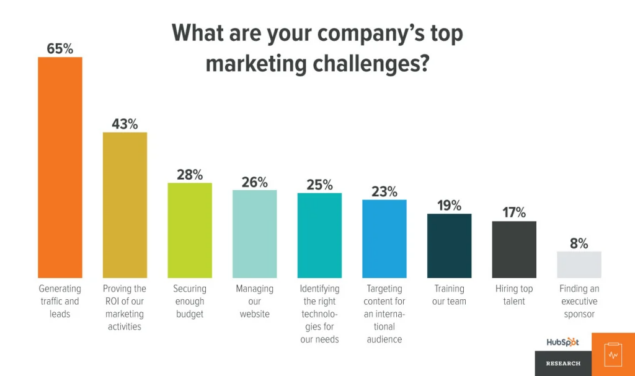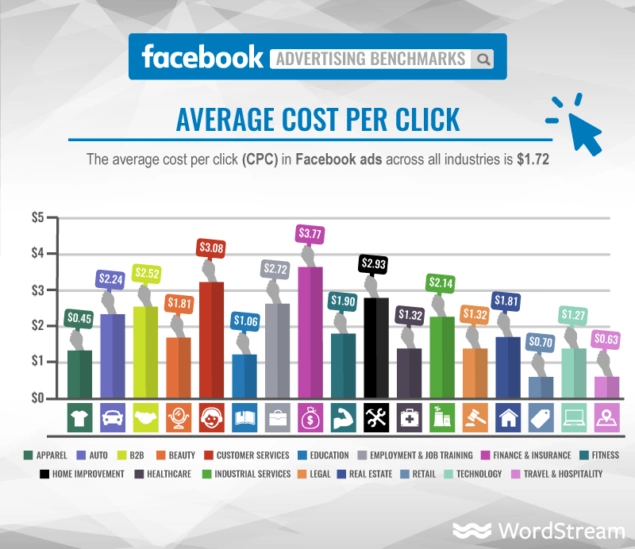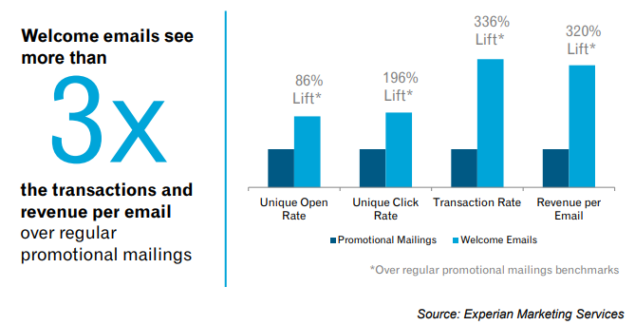As an eCommerce startup you’re competing—either directly or indirectly—with some of the world’s biggest companies. If you’ve just launched a Shopify store or you’re using any of the eCommerce platforms available, you need to find cost-effective ways to make your mark.
With the amount of cash that goes into a startup eCommerce business, there’s often insufficient money left over for marketing. This article aims to help startups circumvent this problem with some low-cost marketing tactics.

According to a study by Hubspot, proving the ROI of a marketing strategy is the second biggest challenge for new businesses.
Luckily, there are lots of low-cost marketing strategies you can take advantage of to drive traffic to your online shop. The best part? They also drive results and deliver an impressive ROI. Simply creating fresh content or asking for product reviews might be all your eCommerce startup needs to take it to the next level!
10 low-cost marketing tactics for eCommerce startups
By adding some of these low-cost digital marketing channels to your strategy, you’re guaranteed to drive sales and reach your business goals.
So, without further ado, let’s find out which low-cost tactics to add to your project planning software and other tools to grow your eCommerce business.
Tactic #1: Grow your following on social media organically
Due to their scale, social media platforms are one of the most efficient ways to get the word out about an eCommerce business, and, as a startup, you should be looking to build an audience of interested, relevant individuals by sharing content you know they’ll find valuable.
Choose one or two platforms you’re confident with and put a regular posting strategy together. It’s recommended to combine promotional content with educational, entertaining, or high-value posts to cover all of your bases and keep your audience engaged.
Depending on your business niche, you may want to share recipes or reading lists, for example. It’s also a good idea to answer questions that people will ask about your product, such as ‘when does Mark’s Cafe open’.
Use free tools like Canva to design engaging posts. Here are some of our favorite ideas for Instagram content. Make sure you’re using relevant hashtags to attract the right audience.
Tactic #2: Use sponsored Facebook posts
Utilizing Facebook advertising is a low-cost marketing strategy that can introduce a relevant audience to your brand, drive traffic to your website, and secure those all-important sales.
You are fully in control of the audience your content is served to. At a cost-per-click of less than $1 for some industries, sponsored Facebook content should be on your radar.

A couple of things you need to be mindful careful of are retargeting and geolocation targeting.
Don’t neglect retargeting in striving to reach brand-new customers. Facebook retargeting helps you reach people who already visited your website and are aware of your brandare already aware of your brand. That makes them easier to convert into customers.
You should also avoid limiting your advertising to a single location if it’s not necessary to do so. This is one of the most common geolocation marketing mistakes that eCommerce startups make. Remember, people are shopping online, so they can be anywhere, especially if you ship internationally.
Tactic #3: Produce content to attract audiences
When you produce content like blog posts and infographics for your audience, you’re delivering useful information alongside your product lines at no extra cost to them. You’re helping people discover you by answering the questions they’re searching for. You’re also giving existing customers a reason to come back.
Put a schedule together so you know what sort of content (blog posts, downloadable white papers, social media content, etc.) you’ll be sharing, who is creating the content, and when it will go live. Keep everyone in your team in the loop by sharing blog titles, ideas, and topics via your company’s collaborative calendar.
In doing so, you’ll ensure your brand gets noticed online, which will drive traffic and sales via your website.
Tactic #4: Use customer reviews to improve brand loyalty
Showcasing customer reviews on your website should be part of your eCommerce marketing strategy. 95% of people read reviews before making a purchase. Your reviews prove you are who you say you are, highlighting the type of customer experience people can expect from your company.
If you feel like you don’t have enough reviews to highlight the benefits of your product, run a campaign via email or social media or try one of these review apps for Shopify. Showcase your best reviews on various online platforms to enhance your credibility and build trust among your audience.
Tactic #5: Utilize budget-friendly email marketing tactics
Did you know you can set up email campaigns to automatically send to your audience when they reach certain milestones?
A welcome series is the collection of emails your customers receive immediately after signing up to your mailing list. At the time of signing up, the receiver of your emails is likely most engaged with your business. At the very least, they’ll remember you and remember giving permission for you to contact them. This may not be the case if you wait longer to reach out.
A killer welcome series is one easy way to connect with prospective customers and maximize the ROI of your email marketing strategy.

But don’t stop there! You can automate as many budget-friendly emails as you want. Start building campaigns for customer birthdays, abandoned carts, and more. You can leverage buyer intent, too, to ID individuals who are researching you and your products, and target them with campaigns.
Tactic #6: Take advantage of referrals
As an eCommerce startup, you should always be on the lookout for referrals to help drive traffic to you.
In the beginning, you’re still building your social media following, and you’ll be competing with major brands to rank in search engine results. Referral marketing can help a relevant audience to discover your website easily.
It’s important you tread carefully, though, when it comes to referral marketing. Don’t approach anyone and everyone to promote your site. Referrals from untrustworthy sources or individuals who clearly aren’t genuine customers will detract from your eCommerce shop’s credibility, damaging the relationship you have with your customers.
Look for and reach out to loyal customers who genuinely love your brand as a first step towards establishing a referral program.
Tactic #7: Host free events
Using a simple web video chatting platform, your business can host virtual events for people all over the world. More people will sign up knowing they won’t have to pay for travel or accommodation.
Just like launching a blog, this marketing strategy allows you to offer more value alongside your product lines and gives customers more reasons to come back to your online store.
For instance, if your store sells items in a specific niche, you could host an industry-specific webinar. Simply by using the expertise already present within your company and a video conferencing platform, you can deliver genuinely valuable information to your customers and prospective customers.
Tactic #8: Run a competition
It’s early days, and most people haven’t heard of you. But there’s something we all have a shared love of…
Free stuff!
To tap into that love, you can run simple yet attractive social media competitions. You might, for instance, ask followers to share an image of a new product, along with a hashtag of your choice. In return, you then pick one follower who does so at random, and send them some of that lovely free stuff—one of those new products, for example.
But it’s not free stuff, is it? In exchange for entry to your giveaway, participants will have to follow you on social media, sign up for your mailing list, or tag their friends in your post. That means thousands of people could be introduced to your brand, increasing awareness and driving sales.
Tactic #9: Attend networking events
Not all of these strategies will work for your particular eCommerce enterprise. Their effectiveness will depend on your business and the product you sell. Networking, on the other hand, is a truncated method of growing a brand across many industries.
By attending networking events, you can build relationships with other business leaders and potential customers. These people may be able to offer advice, help grow your customer base, and help you combat challenges.
In the eCommerce niche, conferences and trade shows are a prime example of such events. The best part is, you may not even have to leave your house. Thanks to the group meeting software that’s available, many of these events are now run online.
You may get invited to smaller breakout rooms too, giving you the opportunity to connect with other attendees on a personal level. Who knows? They might be your next customer.
Tactic #10: Unconventional low-cost marketing strategies
Sometimes, new brands seem to come from nowhere and completely dominate the market. While digital and mobile marketing strategies are fantastic low-cost options, guerilla marketing is another great way to engage potential customers.
One of the best (free) examples of guerilla marketing (that also happened to be gorilla marketing!) was executed to promote the King Kong 3D premier.
Giant footprints appeared on a beach near LAX. As you can imagine, the campaign got a lot of attention and had many people snapping photos to share on social media. All it takes is one clever idea.
Key takeaways
And that’s a wrap. A selection of the best low-cost marketing strategies you can implement to grow your eCommerce store. You’ve probably got a lot to think about. Your mind is buzzing with blog ideas, giveaway prizes, and where to find the right influencers.
Don’t try to tick everything off at once. Test the water, see what works for you, and then throw your all into it. Other than that, you’re good to go. Whether on Shopify or another platform, your eCommerce startup is ready to grow!
FAQ
Should eCommerce startups invest in social media advertising?
Social media advertising is a cost-effective marketing strategy for eCommerce startups. Not only does this boost sales and generate leads, but it also increases brand awareness. And often, there’s little upfront expense.
What should my marketing goals be?
As an eCommerce startup, you might be tempted to go after sales immediately. In a very competitive field, though, you may have to think more long-term.rnrnA more suitable goal for a startup is increasing brand awareness, as you have a better opportunity of building loyal repeat customers who will recommend you to their friends.
Does my eCommerce startup need social media?
Social media platforms allow you to spread the word about your brand, build dedicated audiences, and form relationships.rnrnOrganic social media is free, but sponsored posts are still a cost-effective avenue to explore, and will help you reach a highly targeted audience.




